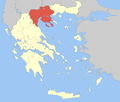Naousa, Imathia
| Naousa Νάουσα | ||
|---|---|---|
 | ||
| ||
 Naousa | ||
|
Location within the region | ||
| Coordinates: 40°38′N 22°4′E / 40.633°N 22.067°ECoordinates: 40°38′N 22°4′E / 40.633°N 22.067°E | ||
| Country | Greece | |
| Administrative region | Central Macedonia | |
| Regional unit | Imathia | |
| Area | ||
| • Municipality | 424.9 km2 (164.1 sq mi) | |
| • Municipal unit | 300.9 km2 (116.2 sq mi) | |
| Elevation | 330 - 450 m (−1,150 ft) | |
| Population (2011)[1] | ||
| • Municipality | 32,494 | |
| • Municipality density | 76/km2 (200/sq mi) | |
| • Municipal unit | 21,152 | |
| • Municipal unit density | 70/km2 (180/sq mi) | |
| Time zone | EET (UTC+2) | |
| • Summer (DST) | EEST (UTC+3) | |
| Postal code | 592 00 | |
| Area code(s) | 23320 | |
| Vehicle registration | ΗΜ | |
| Website | www.naoussa.gr | |
Naousa (Greek: Νάουσα, historically Νάουσσα - Naoussa), is a city in the Imathia regional unit of Macedonia, Greece. Population 32,494 (2011). It is situated in the eastern foothills of the Vermio Mountains, 17 kilometres (11 miles) northwest of Veroia. Naousa is surrounded by orchards, producing peaches, apples, cherries and other fruits. The jam brand name Naousa is known all over Greece. Its dry red wines are also well known, sold under the "Naousa" denomination of origin. Naousa is also known for its parks (Municipal Park, Park of Saint Nicholas etc.) and for its ski resorts (3-5 Pigadia and Seli).
Municipality
The municipality Naousa was formed at the 2011 local government reform by the merger of the following 3 former municipalities, that became municipal units:[2]
- Anthemia
- Eirinoupoli
- Naousa
Province
The province of Naousa (Greek: Επαρχία Νάουσας) was one of the provinces of Imathia. It had the same territory as the present municipality.[3] It was abolished in 2006.
History


The city is situated in ancient Emathia west of the ancient Macedonian town of Mieza and the site of ancient School of Aristotle. The area, according to Herodotus, was where the Gardens of King Midas were situated. Later, in the current position of the city, the Romans established the colony of Nova Augusta. The name changed through the centuries to Niagusta, Niaousta and Niaousa, until it became today's Naousa.
In 1705, an armatolos named Zisis Karademos led an ill-fated uprising in Naousa against the Ottoman authorities.
In 1822, the insurgence of the Greeks of Western Macedonia against the Turks came to a dramatic finale in Naousa. Abdul Abud, the Pasha of Thessaloniki, arrived on the 14th of March at the head of a 16,000 strong force and 12 cannons. The Greeks defended Naousa with a force of 4,000 under Anastasios Karatasos, Aggelis Gatsos, Tsamis Karatasos, Karamitsos and Philippos, the son of Zafeirakis Theodosiou, under the overall command of Zafeirakis Theodosiou and Anastasios Karatasos. The Turks attempted to take the town of Naousa on the 16th of March 1822, and on the 18 and 19 March, without success. On the 24th of March the Turks began a bombardment of the city walls that lasted for days. After requests for the town's surrender were dismissed by the Greeks, the Turks charged the gate of St George on Good Friday, the 31st of March. The Turkish attack failed but on the 6th of April, after receiving fresh reinforcements of some 3,000 men, the Turkish army finally overcame the Greek resistance and entered the city. In an infamous incident, as the rebels were abandoning the town, some of the women left behind committed suicide by falling down a cliff over the small river Arapitsa. Zafeirakis Theodosiou was pursued by a Turkish unit and was killed. The other Greek leaders retreated southwards. Abdul Abud laid the town and surrounding area to waste. The fall and massacre of Naousa marked the end of the Greek revolution in Macedonia in 1822.[4]
Naousa has a large population of Aromanians, also known as Vlachs, and a small Romani population.
Sporting teams
- Naoussa F.C. which played at First National Division of Greece for one year (season 1993-94)
- Zafeirakis of Naoussa (Greek: Ε.Γ.Σ.Ζαφειράκης Νάουσας) is a sporting team of Naoussa.Keeps parts volleyball, handball and basketball. The name refers to the Greek prokritos Zafeirakis Theodosiou (Greek: Ζαφειράκης Θεοδοσίου) (1772–1822).
International relations
Twin towns — Sister cities
Naousa, Imathia is twinned with:[5]
 Asenovgrad, Bulgaria (1994)
Asenovgrad, Bulgaria (1994) Zgorzelec, Poland (1998)
Zgorzelec, Poland (1998)
Notable people
- Anastasios Michail (17th century-1722), theologian
- Zisis Karademos(17th century-1705), armatolos, led a rebellion
- Zafeirakis Theodosiou (18th century-1822), political leader
Gallery
-

Monument of the Heroids of 1822
-

View from St. Theologos hill
-

Agios Nikolaos park
-

View of a vineyard
-
Traditional dress
See also
| Wikimedia Commons has media related to Naoussa. |
- List of settlements in Imathia
- Folklore Museum of the Lyceum of Hellenic Women
- Wine and Vine Museum
References
- ↑ "Detailed census results 2011" (in Greek).
- ↑ Kallikratis law Greece Ministry of Interior (Greek)
- ↑ Detailed census results 1991 PDF (39 MB) (Greek) (French)
- ↑ John C. Vasdravellis, The Greek Struggle for Independence: The Macedonians in the Revolution of 1821 (1968), p. 123-24, 136
- ↑ "Twinnings" (PDF). Central Union of Municipalities & Communities of Greece. Retrieved 2015-01-05.
| |||||||||||||||||||||||||||||||||
| ||||||||||||||||||||||||||||||||||||||||||
| ||||||||||||||
| ||||||||||||||||||||||||||||||||||||||||||||||||||||||||||||||||||||||||||||||||||||||||||||||||||||||||||||||||||||||||||||||||||||||||||||||||||||||||||||||||||||||||||||||||||||||||||||||||



